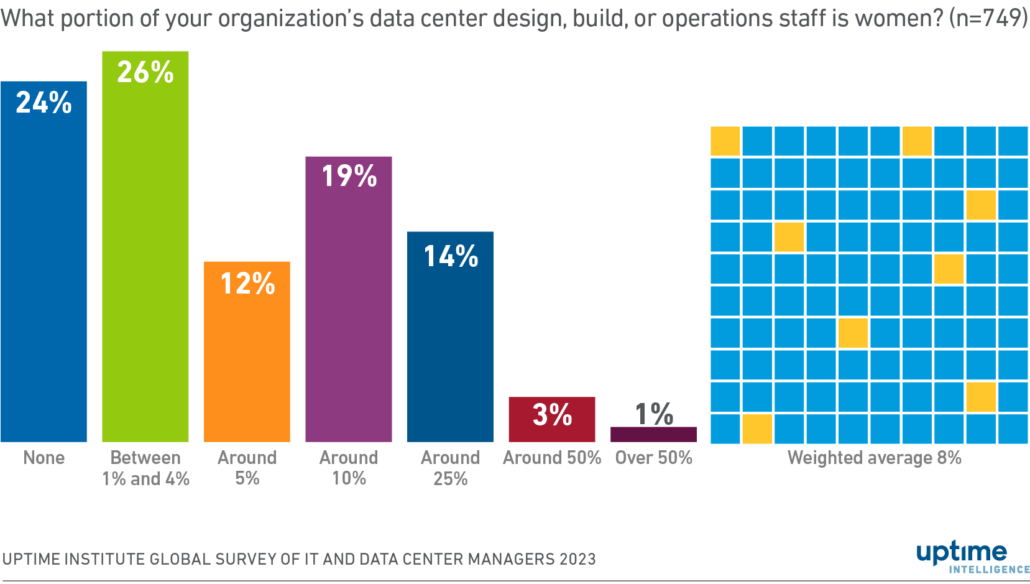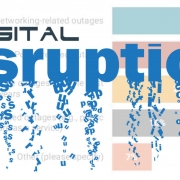Data centers are short-staffed boys’ clubs
Two persistent trends in data center staffing are in apparent tension. The 2023 Uptime Institute Global Data Center Survey confirmed, once again, that operations teams are struggling to attract and retain qualified staff. The severity of this shortage should justify aggressive hiring from all available labor sources — yet data centers still employ shockingly few women. The average proportion of female employees at respondents’ organizations is just 8% — lower than in many physically demanding, conventionally male-dominated industries, such as construction, mining and manufacturing.
In the Uptime Institute Global Data Center Survey 2023 report, Uptime details the staffing shortage that has frustrated the data center industry for more than a decade. Operator responses show that the past four years have been particularly trying for the sector. About half of the survey’s respondents reported difficulty in filling open job positions, and one in four have seen their staff hired away, with most being poached by competitors. Skills shortages affect virtually all job roles but are the most acute among operations, mechanical and electrical staff.
While researching the staffing demands of data center design, build, and operations teams, Uptime has collected gender data since 2018. Figure 1 shows that the majority (81%) of data center teams are overwhelmingly male, with women making up one in 10 workers or fewer. On average, a meager 8% of all teams are made up of women. This year, Uptime calculated this weighted average for the first time, and five years of data reveals no significant change.
Figure 1 Data center teams lack gender diversity

In the 2019 questionnaire regarding hiring initiatives, good intentions abound. Almost three in four respondents agreed the industry would benefit from hiring more women — and 45% said the gender imbalance was a threat to the industry, contributing to the dry talent pipeline and even technical stagnation. Nearly half of respondents were planning initiatives to hire more women — or had such programs already in place. These results suggested a will to invest in hiring women, and an expectation of that investment paying off.
Four years on, the staff shortfall looms large in keynote presentations and data halls alike. So, where are the women? Did the time and money invested in hiring initiatives fail to attract female candidates, or were these plans and initiatives quietly shelved? Regardless of the causes, the gender divide persists, and the benefits of mitigating it remain hypothetical.
Identifying the most relevant influences on the gender balance of the workforce is difficult without any motion in the data — but some explanations can be ruled out by comparison against other industries.
Anecdotally, women are disinclined to pursue manual labor — and labor statistics confirm that physically demanding job roles typically attract fewer women. However, this alone cannot account for the disparity in the data halls. Uptime’s findings suggest data center operations teams employ fewer women than manufacturing (29%), mining (15%) and construction (11%) — according to figures from a 2021 publication by the US Bureau of Labor Statistics (Employment and Wages Online Annual Averages). The construction workforce in western Europe is about 9% women, as per government statistical offices, and the International Energy Agency reports at least 10% women in the mining industry in all regions.
In occupational health and safety research, women describe construction sites as hostile workplaces. Women endure isolation, sexual harassment, and bullying, as well as injuries from tools and personal protective equipment designed for the average size, weight, and grip strength of a male worker. In interviews, women say they experience little job security in construction, and this is discouraging timely reporting of harassment or injuries, and frustrating efforts at improvement. If female workers are choosing such punishing job sites over data centers (even by a small margin), there must be other factors influencing the minimal presence of women — beyond the assumed aversion to physical labor.
Data center operations are not a highly visible career path, and the problem is more pronounced for women. With few female role models in the industry, women may perceive a data center career as unwelcoming or unsafe and may feel discouraged from applying. This cycle is likely to perpetuate itself unless more resources are devoted specifically to closing the gender gap.
Many data center operators now desire better visibility in the labor market and are bringing their organizations out of their habit of comfortable obscurity. To draw in more workers, the industry will need to effectively communicate that it has rewarding careers available for qualified women. An uptick in female representation would strengthen this message and could act as an indicator of early successes for recruitment efforts at large.
To draw future workers from universities and trade schools, some data center organizations have formed educational partnerships and programs — often working with high school students, or younger. Efforts in education to attract more women and girls to careers in data centers must begin today, to produce more gender diversity when these students grow into job seekers.
The data center industry also seeks out workers who are changing careers and can bring some applicable skills with them. Operators can smooth the transition into a data center career by revisiting the advertised job requirements — lowering the bar for entry so candidates can supplement their existing skill sets with training on the job and mentoring programs. Active outreach to women in this talent pool can ensure that fewer qualified candidates are overlooked.
This avenue of recruitment can expand to include “career returners.” Many in this group are women who left the workforce for childcare or family care duties — and operators offering benefits suited to workers with family obligations may gain an advantage in recruitment.
Operators desperate for staff would benefit from understanding what went wrong with female representation in the industry. Ongoing efforts to recruit women must be re-examined and held to account for a lack of return on time and money invested.
To lessen the data center staffing struggle, operators will need to draw from every available labor pool. Women and other underrepresented groups are underutilized resources — and the industry likely will not escape its staffing crisis until it can bring them in.
The Uptime Intelligence View
Gender balance in the data center lags many physically demanding, conventionally male-dominated industries such as construction, mining, and manufacturing — a sign the industry is not doing enough to advertise rewarding career opportunities to women. Data centers cannot afford to let female candidates remain left out. Outreach efforts to career changers, universities, and vocational training could maximize their returns by seeking out more women.



 UI 2021
UI 2021






